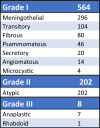Neurosurgical treatment and outcome patterns in patients with meningioma in South Moravian region-a population-based study
- PMID: 38151626
- PMCID: PMC11021287
- DOI: 10.1007/s10072-023-07244-3
Neurosurgical treatment and outcome patterns in patients with meningioma in South Moravian region-a population-based study
Abstract
Introduction: Meningiomas are usually slow-growing tumours, constituting about one third of all primary intracranial tumours. They occur more frequently in women. Clinical manifestation of meningiomas depends on their location, tumour size and growth rate. In most cases, surgical treatment is the procedure of choice. The success of this treatment is, however, associated with the radicality of the resection. Radiotherapy represents an additional or alternative treatment modality. Gamma knife surgery is another notable treatment method, especially in small and/or slow-growing tumours in eloquent areas or in elderly patients.
Material and methods: Authors describe their experience with the diagnosis, treatment and outcome of the patients with meningioma (n = 857). Furthermore, they also assess the postoperative morbidity/mortality and recurrence rate.
Results and conclusions: In view of the benign histology of meningiomas, the success of the treatment largely depends (besides the tumour grading) on the radicality of the resection. The emphasis is also put on appropriate follow-up of the patients. In certain patients, the watch and wait strategy should be also considered as a suitable treatment method.
Keywords: Diagnostics; Follow-up; Meningioma; Treatment.
© 2023. The Author(s).
Conflict of interest statement
All authors certify that they have no affiliations with or in involvement in any organization with any financial or non-financial interest in the subject matter or materials presented in the manuscript. The funder also confirms that it had no role in the design of the study; in the collection, analyses or interpretation of data; in the writing of the manuscript; or in the decision to publish the results.
Figures






References
MeSH terms
Grants and funding
LinkOut - more resources
Full Text Sources

